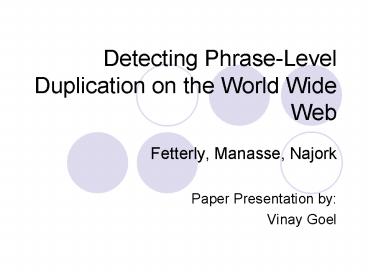Detecting Phrase-Level Duplication on the World Wide Web - PowerPoint PPT Presentation
Title:
Detecting Phrase-Level Duplication on the World Wide Web
Description:
Detecting Phrase-Level Duplication on the World Wide Web Fetterly, Manasse, Najork Paper Presentation by: Vinay Goel – PowerPoint PPT presentation
Number of Views:54
Avg rating:3.0/5.0
Title: Detecting Phrase-Level Duplication on the World Wide Web
1
Detecting Phrase-Level Duplication on the World
Wide Web
- Fetterly, Manasse, Najork
- Paper Presentation by
- Vinay Goel
2
Introduction
- Problem
- Identify instances slice and dice generation
- Example
- German spammer
- 1 million URLs originating from single IP (but
use of many host names) - Pages changed completely on every download
- Pages consisted of grammatically well-formed
sentences stitched together at random
3
Goal
- Find instances of sentence level synthesis of web
pages - More generally, of pages with an unusually large
number of popular phrases
4
The Data
- Datasets
- DS1
- BFS crawl starting at www.yahoo.com
- 151 million HTML pages
- DS2
- Large crawl conducted by MSN search
- 96 million HTML pages chosen at random
5
Finding Phrase Replication
- Sampling
- Reduce each document to a feature vector
- Employ a variant of the shingling algorithm of
Broder et al. - Significantly reduces the data volume
6
Sampling method
- Replace all HTML markup by white-space
- k-phrases of a document all sequences of k
consecutive words - Treat the document as a circle last word
followed by first word - n word document has exactly n phrases
7
Sampling method
- Exploit properties of Rabin fingerprints
- Rabin fingerprints support efficient extension
and prefix deletion - Fingerprints of distinct bit patterns are
distinct
8
Computing feature vectors
- Fingerprint each word in the document - gives n
tokens - Compute fingerprint of each k-token phrase -
gives n phrase fingerprints - Apply m different fingerprint functions
- Retain the smallest of the n resulting values for
each function - Vector of m fingerprints representative of
document (elements referred to as shingles)
9
Duplicate Suppression
- Replication rampant on the web
- Clustered all pages in data set into equivalence
classes - Each class contains all pages that are exact or
near duplicates of one another
10
Popular phrases
- Occur in more documents than would be expected by
chance - Assumptions
- Normal web pages characterized by a generative
model - Sought web pages - copying model (need to
consider number of phrases, length of typical
documents)
11
Popular Phrases
- Limit attention to the shingles chosen by
sampling functions - Phrase is popular if selected as shingle in
sufficiently many documents - To determine popular phrases, consider triplets
(i,s,d)
12
Popular Phrases
- First 24 most popular phrases not very
interesting - Starting from the 36th phrase, discover phrases
caused by machine generated content - Templatic form common text, fill in the blank
slots and optional - 60th phrase - instance of idiomatic phrase
13
Zipfian Distribution
14
Histogram of popular shingles per doc
15
Covering set
- Covering sets for shingles of each page
- Approximate a minimum covering set using a greedy
heuristic
16
Distribution of covering set sizes
17
German spammer
18
Looking for likely sources
19
Conclusion
- Power law distribution
- Popular phrases
- Often limited by design choices
- Legal disclaimers
- Navigational phrases
- fill in the blanks
- More replicated than original content

